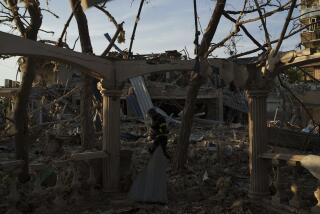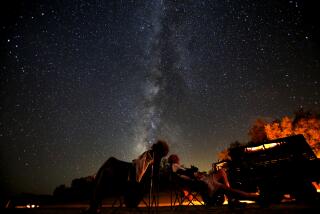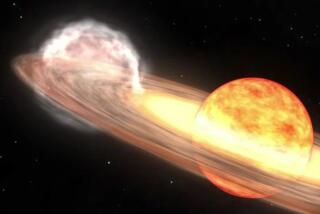Russian scientists collect, study pieces of meteor
MOSCOW -- Russian scientists declared Monday that they have found and established the composition of pieces of the meteor that exploded over the Chelyabinsk region last week, injuring hundreds of people and causing millions of dollars worth of damage.
Over the weekend, 53 tiny pieces of dark porous material were collected near Chebarkul Lake, 60 miles west of Chelyabinsk, the regional center, officials said. The biggest of the finds was 7 millimeters long.
The samples were without doubt meteorites, Viktor Grokhovsky, a member of the Russian Academy of Sciences meteorite committee, said early Monday.
PHOTOS: Meteor over Russia’s Ural Mountains
“We are certainly dealing with the debris of the object that traveled here from outer space, and, based on the initial examination, we can now say that the object was a regular chondrite, which contained at least 10% metallic iron and nickel alloy as well as chrysolite and sulfite,” Grokhovsky, who is a professor at Yekaterinburg-based Urals Federal University, said in a phone interview. “We sent our team to the lake as soon as we heard of the meteor falling, as it is extremely important to find and study fresh debris resulting from the explosion.”
In the wake of the explosion Friday, area residents discovered a 24-foot-long hole in the thick ice on the lake, and some claimed to have seen something large fall into the water.
Police cordoned off the lake the same day, and a team of divers worked all day Saturday to try to retrieve any part of the meteor they could find at the bottom of the lake. But divers were not able to find anything they thought might be a piece of the meteor, officials said.
“The fact that the divers’ initial inspection produced nothing absolutely doesn’t mean a big chunk of the meteorite is not there, and I am absolutely confident it should be there now that we have established its solid composition,” Grokhovsky said. “The divers involved in the search were not scientists and they simply didn’t know what to look for.”
Grokhovsky said the particles that he and his colleagues studied showed signs of melting, indicating that “they most likely were parts of the meteor’s surface.”
“We certainly need to take another go at the bottom of the lake as soon as possible and do it as professionally as we can,” Grokhovsky added, with a complaint about a lack of funding to do the expensive research on his own.
He said scientists were planning to name the meteorite Chebarkul, because the largest part of the meteor is believed to have fallen into the lake.
The search for meteorites was not only being carried out by officials and scientists. Some enterprising local residents were offering what they claimed to be fresh meteorite pieces for sale online for as much as the equivalent of $10,000 a piece.
The meteor entered Earth’s atmosphere Friday morning over north Kazakhstan and traveled over the vast territory of Russia before exploding over the Ural Mountains region. It was about 55 feet wide with a weight of about 10,000 tons, NASA said, estimating the power of the blast at 500 kilotons, or as powerful as an explosion of several nuclear bombs.
The shock wave from the blast damaged thousands of homes and buildings, shattering over 1,000,000 square feet of window glass. Hundreds suffered minor injuries. A woman who suffered a broken spine was flown to Moscow for surgery and treatment, the Emergency Situations Ministry said.
[For the Record, 8:12 a.m., Feb. 18: An earlier version of this post stated that the meteor shock wave shattered windows over an area of 1,000 square feet. It should have stated that the blast shattered over 1,000,000 square feet of window glass.]
A 150-foot-wide asteroid named 2012 DA 14 came as close as 17,200 miles from Earth within hours of the meteor event. The asteroid had a trajectory different from the Chelyabinsk meteor, leading scientists to conclude the two events were a coincidence, NASA said.
Scientists were aware of the asteroid and had previously concluded that it posed no threat to the planet, despite its size.
The surprise meteor explosion over Chelyabinsk spurred talk among Russian scientists and officials about the need for a reliable warning and protection system.
“It was impossible for us to track the [Chelyabinsk] meteor in advance ... as it was approaching from the east and completely lost in the light of the rising sun,” Vladimir Lipunov, head of the Space Monitoring Laboratory with Moscow State University, said in an interview. “If the meteor had fallen or exploded low [in the sky] above one of the numerous military or nuclear facilities near Chelyabinsk, the consequences would have been far more catastrophic.”
Lipunov runs a network of four 15.7-inch telescopes positioned from Kislovodsk in the south of Russia to Blagoveshchensk in its far east, but they are incapable of detecting meteors and small asteroids, he said.
[Updated, 11:35 a.m. Feb. 18: Russian scientists together with Roskosmos, the country’s space agency, have submitted a proposal to the government for an early warning system to protect Russia from future space threats, Lidiya Rykhlova, a senior researcher with the Institute of Astronomy, told the RIA-Novosti news agency. The program, involving new and larger telescopes, would cost almost $2 billion over the next decade, Rykhlova said.]
ALSO:
Pope blesses thousands as details of ailments emerge
U.S. general is willing to curb airstrikes in Afghan villages
Venezuela releases first photos of Hugo Chavez after surgery
More to Read
Sign up for Essential California
The most important California stories and recommendations in your inbox every morning.
You may occasionally receive promotional content from the Los Angeles Times.









